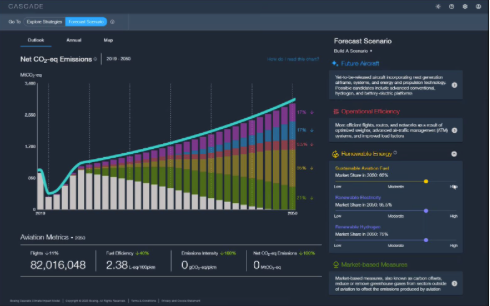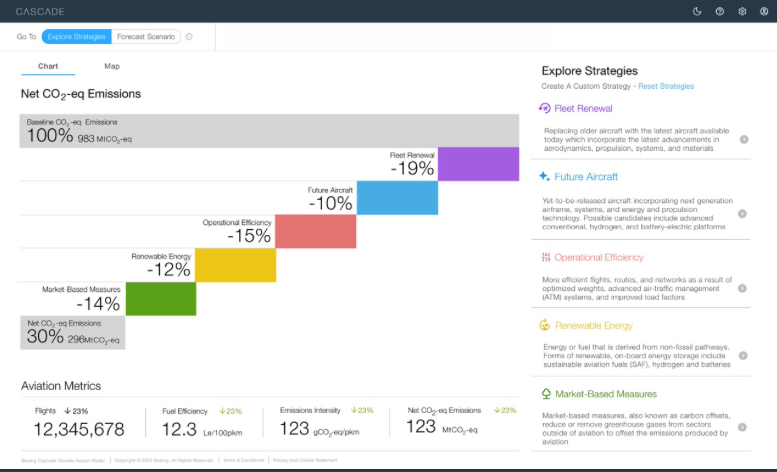Boeing Unveils Cascade Climate Impact Model to Drive Net Zero Carbon Emissions in Aviation

Leading aerospace company, Boeing, has taken a significant step towards achieving net zero carbon emissions in commercial aviation with the release of the Boeing Cascade Climate Impact Model. The company unveiled its data modeling tool to the public on Wednesday. The tool enables stakeholders to assess the impact of various sustainability solutions in reducing carbon emissions in aviation.
Cascade provides a comprehensive analysis of the complete life cycle of alternate energy sources for aviation, including production, distribution, and use. By quantifying the ability to cut carbon emissions, this data modeling tool evaluates airplane fleet renewal, operational efficiency, renewable energy sources, and market-based measures as pathways to decarbonization.
Boeing’s Chief Sustainability Officer, Chris Raymond, stated, “We created Cascade to serve as an industry tool that creates a common framework among aviation, energy, finance, and policy. By putting data first and sharing this model with the public, we are enabling collaboration, feedback, and alignment across industry, government, and others who work together to achieve a more sustainable aerospace future.“


Key findings from Cascade’s assessments highlight the importance of the overall energy transition in the journey to net zero emissions. Regardless of the fuel type used, minimizing the energy and emissions associated with production, distribution, and storage of fuels is crucial for achieving the most sustainable outcome.
Cascade indicates that SAF will have the most significant impact in reducing carbon emissions since it can be used in both new and existing commercial airplanes. Given that many jets currently in service will continue to operate until the 2040s and beyond, it is vital to mitigate their emissions through the use of SAF.
While electric- and potentially hydrogen-powered aircraft are expected to emerge in the future, their contribution to emissions reduction is projected to be limited until 2050. This limitation is due to the lengthy development and deployment timeframes for these technologies and the magnitude of infrastructure changes required for airports and pipelines.
Another component to reducing carbon emissions in aviation is the renewal of fleets with fuel-efficient airplanes. It is expected that newer, more efficient aircraft will play a significant role in reducing emissions in the coming years.
Neil Titchener, Cascade Program Leader, emphasized the significance of the model, stating, “Cascade helps airline operators, industry partners, and policymakers see when, where, and how different fuel sources affect their sustainability goals. Our industry has really hard questions ahead of us, and we’re going to have to make difficult choices. Cascade can be the conversation starter for how each decarbonization pathway can help us reach a more sustainable future.“
Boeing unveiled Cascade at its first Sustainable Aerospace Together Forum, a conference that brought together leaders from commercial aviation, government, and the energy and finance sectors.
In addition to the release of Cascade, Boeing announced the formation of the Cascade User Community, a working group comprising organizations such as IATA, NASA, University of Cambridge’s Aviation Impact Accelerator, and the MIT Laboratory for Aviation and the Environment. This community will provide feedback on new features, functionalities, and application programming interfaces, ensuring continuous improvement and effectiveness of the tool and data sources. “The Cascade User Community will ensure the tool and data sources continue to get feedback and evolve for informed and effective discussions towards achieving net zero emissions by 2050,” said Chris Raymond.
Sustainability in aviation faces several challenges that need to be addressed for the industry to achieve its net zero carbon emissions goals. The aviation sector heavily relies on fossil fuels, resulting in significant carbon emissions. Transitioning to sustainable aviation fuels (SAF), hydrogen, and electric-powered aircraft requires extensive infrastructure changes and long development timeframes.
Additionally, the production, distribution, and storage of alternative fuels need to be optimized to minimize energy consumption and emissions throughout their life cycle. Balancing the need for fleet renewal with fuel-efficient airplanes while considering operational efficiency and market-based measures further adds complexity to the sustainability equation in aviation.
The Cascade model is accessible on Boeing’s new Sustainable Aerospace Together hub, www.sustainabilitytogether.aero.
CleanEarth Media
Popular Now
More From Clean Earth










